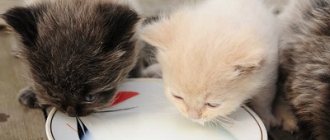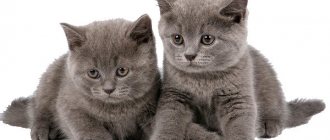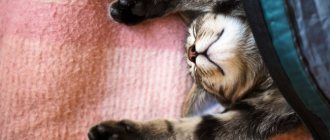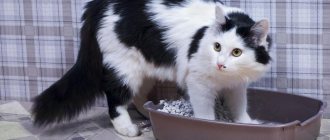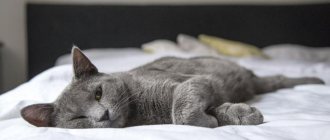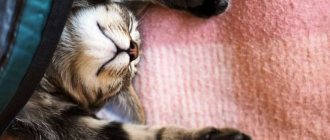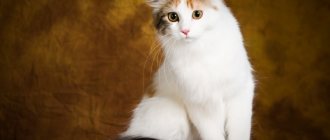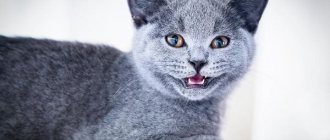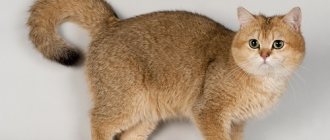While the kitten is growing, it is important to monitor its weight gain. This will allow you not to miss possible deviations in the baby’s development or health problems with his mother.
A table that shows the development norms of this breed depending on the age and gender of the pet will help you control the weight of a Scottish kitten by month.
Newborn kitten weight
A newborn kitten should weigh in the range of 60-140 grams, and if the indicators differ greatly from the norm, this may indicate health problems. Then the baby will need more careful care.
The worst thing is when the pet is underweight - feeding such kittens is the most difficult.
Important! Caring for Scottish cats during pregnancy directly affects the health of the offspring. If she ate well and did not get sick, this significantly increases the chances of having healthy babies.
Foods that should not be fed to Scottish Fold cats
For the correct development of the immune system of a Scottish kitten, a correct diet is necessary, excluding the list of some products that are unacceptable for feeding animals of this breed.
A Scottish Fold kitten should not be given:
- fat meat;
- bones (meat, fish);
- raw and fried river fish;
- pure cow's milk;
- raw eggs;
- dry food in the budget category;
- food from the human table;
- medicines for people, including vitamin complexes.
Despite the fact that healthy vegetables, grains and fruits must be present in a kitten’s diet, some types should also be excluded from this category:
- Due to possible problems with the gastrointestinal tract, it is not recommended to feed a fold cat with potatoes, tomatoes and rhubarb.
- Legume products can provoke unfavorable fermentation in the intestines, so they should not be included in the diet of a purebred pet.
- Serious indigestion problems and allergic reactions can occur after eating citrus fruits. It is also better to exclude them from your favorite kitten’s menu.
- It is also unacceptable to give your lop-eared cat onions and garlic. These foods can cause anemia.
- Another product undesirable for feeding the Scottish representative is mushrooms. The animal’s body does not produce the enzymes necessary for their absorption.
Weight gain in the first days of life
During the first two weeks, babies actively recover from their mother's milk, so you need to monitor the cat's nutrition. On average, a healthy kitten gains about 10-20 grams per day, and at the age of two weeks it already weighs 300-400 grams.
Female cats weigh less than male cats, but the figures do not differ much. Ideally, babies should gain 100-200 grams per week.
By 3 weeks of age, kittens grow up, become stronger and begin to eat complementary foods, although the basis of the diet should remain mother's milk.
As complementary food, you can use age-appropriate natural products or premium dry food for small kittens.
What affects a cat's growth?
The intensity of an animal’s development and its growth parameters depend on a combination of factors, including:
breed of animal. It determines the appearance and size of an adult cat. The desire of the owners to raise a giant from a representative of a small breed leads to the fact that the animal begins to be fattened. Extra pounds negatively affect the health, abilities and well-being of the cat;
- hereditary factor. Simply put, to find out what a kitten will be like, you should take a closer look at its parents. The offspring are rarely larger than the ancestors, although there are exceptions to the rule;
- age. In the first years of life, the body develops intensively. Young cats are rarely well-fed because everything is growing. At the age of puberty, they begin to mature, that is, to increase in volume, acquiring the features and parameters of an adult animal;
- floor. Female cats are smaller than their male counterparts. They are shorter and grow less heavy, but with good nutrition they can be quite weighty.
Health status also matters, in particular:
hormonal status. Improper functioning of the internal secretion organs affects the condition of the body. Hormonal problems in cats, like in humans, can lead to both obesity and underweight. A separate topic is castration (sterilization). A timely and correctly performed operation does not worsen the animal’s health, and in some cases even saves life. At the same time, an animal that has lost the ability to reproduce gains weight faster. This is due to the fact that the cat becomes calmer, sleeps more and moves less;
early onset of sexual activity and frequent lambing. Veterinarians and felinologists have come to the conclusion that mating should begin no earlier than the age of physiological maturation (not to be confused with puberty!), otherwise this may negatively affect the growth rate of the animal. Frequent cat births also become an unbearable burden for the body. The female does not have time to recover, the body wears out. Young cats that give birth often appear emaciated and grow poorly;
In addition to the above, the following circumstances affect the growth of a cat:
regularity of nutrition, . The first two indicators directly depend on the age of the animal. A cat that eats plenty several times a day will grow well. As for the quality of the feed, the nutritional system should be taken into account. When an animal “sits” on a natural diet, the diet must be balanced, taking into account the characteristics of the cat’s body and satisfying its needs for proteins, vitamins and other important microelements. It is not easy to provide an animal with such a diet without resorting to additional vitamin and mineral supplements.
If your animal consumes ready-made food, it is important to choose premium products. Such products have an ideal composition and fully meet the cat's needs.
We should not forget that the animal must consume a sufficient amount of water;
habitat and external conditions. Animals that roam freely on the street, sleep little, are overheated or hypothermic, and are under constant stress do not grow well. It may seem that we are talking about stray cats, but animals that are considered masters, but in fact spend most of their lives on the street, suffer no less, and therefore are almost no different from strays. They are rarely well-fed and healthy, so they do not grow to their full potential.
From 1 to 3 months
During the second month of life, Scottish kittens continue to actively gain weight, which during this period ranges from 400 to 1500 grams. The owner needs to remember that the pet’s gender directly affects its body weight.
If figures of 400-600 grams are normal for a cat, for a cat of 2 months this is considered underweight.
The third month is characterized by a decrease in growth rate; during this period, the pet’s body weight is approximately 1-2.5 kilograms.
How old do Scottish cats grow?
Scottish Fold cats, like straight-eared ones, become teenagers at 4-6 months. By this time, the females begin to estrus, and the males become eligible bachelors. At the age of more than a year, an adult gains no more than 500-700 grams up to 2.5 years.
How long your pet will gain weight is determined by its health, tendency to overeat, and mobility. But when answering the question, to what age do cats grow, we can answer unequivocally that at 2.5 years growth stops.
You can determine the age of a Scottish Fold cat by human standards by multiplying the number of cat years by 7.
Kitten weight table by month
For clarity, below is a table with detailed information on how the indicators for the Scottish fold change.
| Age | Cat, g | Cat, g |
| Newborn | 70-145 | 60-140 |
| 2 weeks | 340-420 | 140-360 |
| 1 month | 400-720 | 240-600 |
| 3 months | 1500-2500 | 1000-1500 |
| 6 months | 3000-5400 | 2300-3600 |
| 8 months | 3500-6000 | 2500-4200 |
| 10 months | 4100-6700 | 2500-4500 |
| 1 year | 4500-7000 | 2500-4800 |
The table shows that Scottish Fold and Straight cats gain weight unevenly. In the first weeks of life, the indicators increase very quickly, since at this time the animal is actively growing. The older the pet, the more stable its weight and size become.
Important! If a cat weighs about 5 kilograms at 1 year, over the next year he can lose 500-800 grams, and this is normal. But if your pet has lost more than 1.5-2 kilograms, you need to contact a veterinarian.
What can I do to make my cat get better?
First of all, understand the reasons for thinness
If the animal is healthy, you should pay attention to the diet
On natural food
You should not feed your pet fatty foods. It will contribute to the increase in adipose tissue, which will make the cat bigger and heavier, but will be a colossal burden on the liver. A pet will gain weight faster and without risk to health when there is a lot of meat in its diet, and feeding will be carried out in small portions, several times a day.
To build muscle mass, you need proteins - animal and vegetable. For this purpose, it is recommended to give the cat:
beef and offal
It is important that the meat is pre-frozen. Before feeding the pet, the product is allowed to thaw to room temperature;
It is recommended to include lean meat (beef) in your cat’s diet.
- cartilage broth;
- chicken meat, preferably breast. Despite all the benefits of chicken, you should not get carried away with it, so as not to provoke an allergy in your cat;
- eggs, preferably quail;
- bran and oatmeal in the form of porridge;
- boiled sea fish, boneless and in moderation;
- cream with less than 10% fat content;
- fermented milk products (kefir, yogurt, cottage cheese), which are also a source of calcium and also contribute to better digestion of food.
On the finished core
In this case, everything is much simpler. As a rule, cats that eat premium food look healthy and well-fed. This is explained by the fact that the compositions are perfectly balanced and contain the entire complex of elements necessary for normal nutrition of the cat. Each manufacturer's line includes products for animals that take into account their age, health status and other characteristics.
It’s not easy to navigate the assortment. To do this, you need to know everything about your pet, down to its taste preferences, which will greatly simplify the task. Each food package contains detailed information about the composition of the product, as well as which cats and in what quantity it is best to give the product.
As for economy segment feeds, they contain practically no meat. Cats that consume such food for a long time receive insufficient nutrition, which may have adverse effects on their health. Those who believe that the problem can be solved by feeding their pet chicken or cutlets are mistaken:
- firstly, food familiar to people is not always suitable for cats;
- secondly, you should strictly adhere to the chosen nutrition system. That is, you cannot feed the animal both “dry” and “natural” at the same time.
A cat's digestive system adapts to process certain types of food. Thus, dry food is digested easily and quickly, while natural food takes longer to digest. The combination of elements of both nutritional systems threatens serious eating disorders.
What to do if your weight is not normal
If underweight or overweight does not exceed 200 grams, then there is no reason to worry; most likely, the pet simply overate a little or did not move much. But if there is a large deviation from the norm, you need to contact a veterinarian, who will determine the cause and, if necessary, prescribe a course of treatment.
If your weight is below normal
If your Scottish Fold cat's weight at any stage of its growth is significantly below normal, you need to take your pet to a veterinarian. If the animal does not have problems with the gastrointestinal tract, the specialist will prescribe vitamins and give recommendations on changing the diet.
If your weight is higher than normal
Excess weight in a cat often causes the development of serious diseases, so the owner needs to monitor the diet and try not to overfeed the pet. If your pet is already overweight, you should review its diet and gradually reduce the portion size.
You will also have to take care of physical activity - you need to play with the cat more often to burn extra calories.
How to weigh
Determining the weight of a kitten at first glance seems somewhat complicated. However, everything is quite simple.
Methods:
- The first method is the most common, weighing on an electronic kitchen scale. Such scales show the result quite accurately, making weighing kittens from 0 months old very easy and simple.
- The second method also has the right to life. Here it is suggested to use commercial hand scales with a hook. To measure mass this way, you will need a bag or some other container to place the cat in. The container is pre-weighed separately. This method of measurement is far from the most accurate.
- The third method is more likely for adult animals whose weight is from 1 kg. You need floor scales on which you weigh yourself and then weigh yourself with your pet. The difference between the first and second weighing will be equal to the weight of the cat.
- The surest, but not the most convenient way, is to weigh the kitten in a veterinary clinic on special scales.
Dimensions of an adult animal
At the age of 2 years, a pet can weigh about 4 kilograms with a body length of 55 centimeters (without tail). Unlike the giant Maine Coons, Scots grow into medium-sized cats. The height of an adult cat at the withers reaches 30 centimeters.
If the pet belongs to the show class, you need to take into account the volume and size of its paws and tail. If the tail is bent along the body, it should reach the shoulder blades, and the paws should not be too short or thick.
The Scots are characterized by rounded body lines and a wide chest. These are cats with long whiskers and a round muzzle.
ATTENTION, TEST! Answer a few simple questions and find out what kind of owner you are for your cat:
Does your cat have a name?
How often do you play with your pet?
Do you get your vaccinations and parasite treatment up to date?
Is your kitten spayed/neutered?
What do you feed your purr?
Share your Results:
Facebook Twitter Google+ VK
You can determine how much your pet weighs using kitchen scales and later floor scales. By the age of four months, Scots weigh about 2 kilos. These are independent, active animals that need sufficient calories and vitamins. They are actively growing.
What weight category a pet occupies depends on its genetic predisposition and quality of nutrition. The owner needs to decide whether to give the baby ready-made food or prefer natural food from products that should be prepared separately for the pet without salt and spices.


